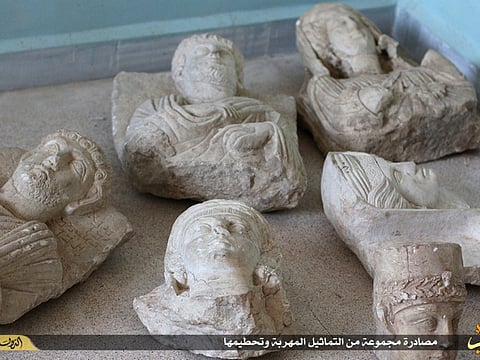Daesh says it destroyed archaeological pieces from Palmyra
Daesh terrorists destroyed six archaeological pieces from historic town of Palmyra

Beirut: Daesh terrorists have destroyed six archaeological pieces from the historic town of Palmyra that were confiscated from a smuggler, the group said.
A Daesh statement released late on Thursday said the six busts were found when the smuggler was stopped at a checkpoint. The issue was referred to an “Islamic court” in the northern Syrian town of Manbij, which ordered that they be destroyed and the man be whipped.
Photographs released by the group showed Daesh fighters destroying the busts with large hammers. Another photo showed the smuggler being whipped.
The Britain-based Syrian Observatory for Human Rights said on Friday it was unclear if the busts were authentic or if the militants destroyed fake busts as a cover for the Daesh group’s own antiquities smuggling.
While there is no firm evidence of the amount of money being made by Daesh from looting antiquities, satellite photos and anecdotal evidence confirm widespread plundering of archaeological sites in areas under Daesh control.
Daesh captured the historic Syrian town of Palmyra in May from government forces. Many fear that the group will damage the town’s archaeological sites as they did in neighbouring Iraq earlier this year.
Palmyra’s Unesco World Heritage site is famous for its 2,000-year-old Roman colonnades, other ruins and priceless artefacts. Before Syria’s conflict began in 2011, tens of thousands of tourists visited the remote desert outpost, a cherished landmark referred to by Syrians as the “Bride of the Desert.”
In March, Daesh members in Iraq razed 3,000-year old Nimrod and bulldozed 2,000-year old Hatra — both Unesco World Heritage sites.
The extremists, who have imposed a violent interpretation of Sharia in the territories they control in Syria and Iraq, believe ancient relics promote idolatry.
Daesh militants also recently destroyed a lion statue dating back to the 2nd century in Palmyra, said Mamoun Abdul Karim, the head of the Syrian government’s Antiquities and Museums Department.
He said the statue, discovered in 1977, had stood at the gate of the town’s museum, and had been placed inside a metal box to protect it from damage.
Sign up for the Daily Briefing
Get the latest news and updates straight to your inbox


